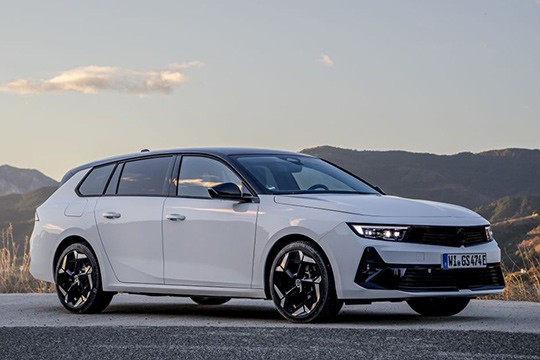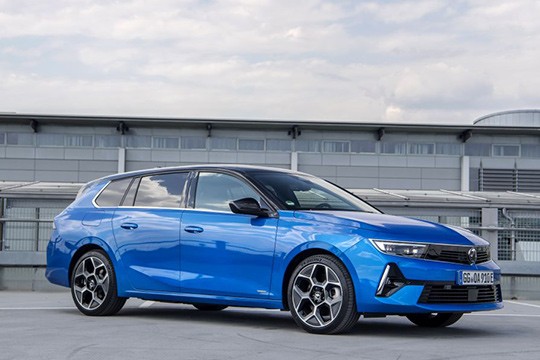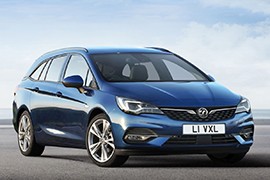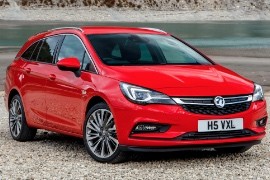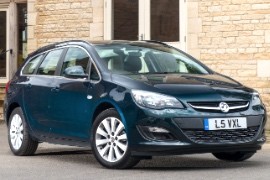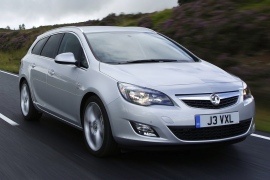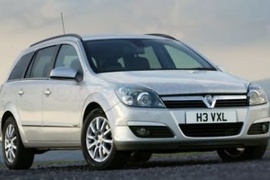VAUXHALL Astra Estate Models/Series Timeline, Specifications & Photos
First production year: 2004
Engines: Plug-in hybrid, Gasoline, Diesel
Body style: Wagon (station wagon, estate, combi, touring)
More than a year after it introduced the station wagon of the Astra L generation, Vauxhall also unveiled the sportiest version for it in late 2022.
While the Astra Sports Tourer was already trendy on the British market, customers kept asking for a more potent version of the car. The answer came in November 2022 when, along with the Astra L Hatchback GSe and the Grandland GSe, Vauxhall introduced the station wagon version of its compact hatchback, also known as the Astra Sports Tourer. Since the car was based on Peugeot’s EMP2 platform, the development process went smoother. However, the automaker still needed some time to implement the technology and thoroughly test it before the launch.
The car’s front fascia carried over some of the design elements inherited from the 2009 Astra. Its L-shaped daytime running lights integrated into the headlights’ upper outer corners were a powerful statement, and Vauxhall kept them. Between them, the car sported the new Vauxhall Vizor grille, which featured black horizontal slats across it. On the lower bumper, the automaker placed a broad lower air intake that integrated the radar for its advanced safety systems and a pair of side scoops that housed the fog lamps.
From its profile, the long-roof version of the Astra L featured sculptured lines on the lower side of the bodywork, which ascended on the rear doors toward the wheel fenders. Its predecessors had those two, but those followed curved lines, not sharp ones like the 2022 Astra. The automaker installed a third row of windows next to the trunk space between the C- and D-pillars. Finally, at the back, the car featured slim LED taillights that were extended from the rear quarter panels to the raked-forward tailgate. As a final touch, the automaker installed a roof spoiler that housed the third brake light. Unlike its predecessors, the 2022 Sports Tourer had the same low-cut in the bumper as the Astra Hatchback.
Inside, Vauxhall installed advanced technological pieces of equipment carried over from Peugeot. The dashboard sported a pair of screens, one for the instrument panel and the other for the infotainment system. In addition, the car had a head-up display projected onto the windshield. Between the front bolstered seats developed with the German Institute for a Healthy Back, the automaker placed a wide center console, which housed the driving modes, a pair of cup holders, and a few storage areas. But the car’s main asset was in the back, where the 40/20/40 split-folding bench seat could expand the trunk space from a decent 597 liters (35.1 cu-ft.) to a massive 1,553 liters (54.8 cu-ft).
Under the hood, Vauxhall installed a 1.6-liter turbocharged gasoline engine carried over from Peugeot. In addition, it added a 110 PS (108 hp) electric motor fed by a 12.4 kWh battery. As a result, the total power output of the vehicle was a respectable 225 PS (222 hp) sent to the front wheels via an eight-speed automatic transmission.
Vauxhall introduced its first station wagon version for the Astra lineup in late 2022, trying to get a slice of this specific niche of the compact segment.
Stellantis, as the owner of the Vauxhall brand, didn't want to sell the Astra just as a compact hatchback, like GM. Instead, it created a long-roof version even though that meant that this model had to compete against the Peugeot 308, which provided a similar vehicle built on top of the EMP2 platform.
On the visual side, the front bumper was modified so it could fit a broad, U-shaped grille, incorporating the fog lamps on the sides. Likewise, the main grille was slightly pinned-down, sporting a wide V-shaped lower line. Like its 5-door sibling, the Sports Tourer shared most of its body panels with the rest of the Astra range. However, the long-roof version received a new set of rear doors and a row of windows between the C- and D-pillars. In addition, the rear bumper was slightly different, with a narrower diffuser underneath the rear bumper.
Inside, the carmaker installed a fully digital Pure Panel with two large 10-inch widescreen displays. The dashboard's minimalist design and the center console's clean lines were part of Opel's design philosophy. The 2023 Astra Sports Tourer could provide 516 liters (18.2 cu-ft) of space with the rear bench up, or 1,553 liters (54.8 cu-ft) with the backseats folded down.
Under the hood, the automaker installed a wide choice of engines ranging between 110 and 180 PS (108-177 hp) paired with either a six-speed manual or an eight-speed automatic.
Vauxhall launched the facelifted version for the Astra K generation in 2019, four years after the model’s introduction to the British market, and there were massive changes.
After several years of struggle to keep the Opel/Vauxhall brands under its roof, GM decided to sell both brands in 2017 to PSA (Peugeot-Citroen). Even if the French automaker already has its own contenders in the compact segment, it decided to upgrade and keep producing the Astra due to the car’s brand awareness. A quarter of the British drivers had already owned or drove one, so it just made sense to keep the vehicle’s lineup on the assembly lines. Besides the GTC and the hatchback, the station wagon, also known as Sports Tourer, was one of the best blends of interior space, comfort, and perceived interior quality on the market.
Like most facelifts, the 2019 Astra Sports Tourer featured a redesigned front fascia that made it stand apart from its non-facelifted version. It had new headlights with an option for IntelliLux LEDs that provided better illumination on the road. Furthermore, these could keep their high beams on even when an oncoming vehicle approaches since they could turn off some of the light-emitting diodes to not blind other drivers. The redesigned version featured a 3D mesh grille that covered the area between the headlights, while the lower bumper got a more aggressive styling, with an A-shaped lower air intake flanked by the scoops for the LED fog lamps.
Thanks to the improved front fascia and the already sleek profile, the long roof version of the Astra boasted a 0.26 drag coefficient. Its doors featured a lower sculptured line that ascended upwards toward the rear doors. At the same time, the floating roof design line was emphasized by the third triangular windows next to the trunk space and a chromed trim that adorned the D-pillar. Finally, at the back, the raked-forward tailgate sported a roof spoiler at the upper side of the window.
When Vauxhall designed the Astra, it made it with a nice-looking interior. Moreover, it boasted soft-touch materials on the dashboard, door cards, and the center console. There, the new owner couldn’t do too much, so it turned its attention towards the infotainment system. Besides the lower-level ones fitted with seven-inch touchscreens, the automaker offered an option for an eight-inch unit carried over from the Vauxhall Insignia. Regardless of the version, all of them featured Apple CarPlay and Android Auto.
But the most significant changes happened under the hood. There, PSA insisted on installing its own engines ranging between 105 PS (103 hp) and 145 PS (143 hp). Besides the manual and automatic gearboxes, the automaker offered the option for a CVT with seven pre-established speeds.
Vauxhall introduced a new station-wagon version of the Astra in 2015, along with unveiling the car’s seventh generation, a very popular model in the UK.
While the world financial crisis was already gone by 2015, its effects still troubled the European arm of the American automaker General Motors. In Europe, the compact segment was one of the most contested, and many car brands had highly acclaimed models there. So, Vauxhall charged with everything it had in its arsenal, including the station wagon version of the Astra, named Sports Tourer, a vehicle designed for families and those needing roomier cars but without the hassle of a mid-size vehicle.
GM’s styling department changed the pace when it shaped the front end of the Astra. As a result, the car still had some organic influences, especially on the headlights, which sported new LED daytime running lights that contoured the main Xenon lamps inside them. Furthermore, the DRLs also doubled as turn signals. The main grille was broader than on the previous Astra generation and featured a chromed trim that resembled a wing supporting the Vauxhall’s badge in the middle. Lower, on the apron, the automaker installed a second A-shaped air intake, which was flanked by the side scoops for the available fog lamps.
From its profile, the Astra Sports Tourer long roof version had the same design as the hatchback up to the B-posts. The rear doors, on the other hand, were new. Behind them, Vauxhall installed a third set of triangular windows that flanked the trunk space, while at the back, the raked forward tailgate sported a roof spoiler on its upper side. Thanks to the chromed trim that marked the upper side of the window line, the automaker created a floating-roof design for Astra’s station wagon. Like on the previous Astra J generation, the Astra K Sports Tourer had a lower loading area cut into the rear bumper.
Inside, the Astra K was greatly improved, using several components from its bigger sibling, the Insignia. Its piano-black trims across the cabin and the soft-touch materials used on the dashboard, door cards, and center console improved the perceived quality feel of the car. Fronting the driver was a new instrument cluster filled with wide dials for the tachometer and speedometer and two gauges for the fuel level and coolant temperature on its upper side. In addition, a TFT display mounted on the lower side of the panel offered additional information from the car’s onboard computer. Vauxhall also greatly improved the infotainment system, which featured a seven or eight-inch touchscreen atop the center stack, depending on the trim and options. It was compatible with Apple CarPlay and Android Auto. In the back, the split-folding bench was wide enough to accommodate three passengers. Unlike the hatchback version, the Sports Tourer offered a vast trunk measuring 540 liters (19 cu-ft). With the rear seats folded flat, that value increased to 1,630 liters (57.3 cu-ft).
Under the hood, Vauxhall installed a range of seven gasoline and diesel engines ranging between 105 PS (103 hp) and 200 PS (197 hp) paired with a six-speed manual or a six-speed automatic.
VAUXHALL Astra Sports Tourer 1.0L Turbo 5AT (105 HP)
VAUXHALL Astra Sports Tourer 1.0L Turbo 5MT (105 HP)
VAUXHALL Astra Sports Tourer 1.4L 5MT (100 HP)
VAUXHALL Astra Sports Tourer 1.4L Turbo 6AT (150 HP)
VAUXHALL Astra Sports Tourer 1.4L Turbo 6MT (125 HP)
Vauxhall improved the Astra J lineup in 2012, three years after the model’s introduction on the British market in 2009, bringing more technology to the appreciated compact-sized vehicle.
Those looking for a more spacious vehicle who, for some reason, didn’t want to go to the mid-size segment could get the station wagon version of the Astra J. It offered the same level of practicality as larger cars but in a smaller package. In addition, thanks to the refreshed version of the Astra’s lineup offered by Vauxhall in 2012, the Sports Tourer was even more attractive thanks to its new engines and improved look.
The restyled Astra J Sports Tourer featured a redesigned front fascia, featuring new lights that integrated the L-shaped LED daytime running lights. Its upper grille got a chromed trim that crossed it in the mid-section and supported the Vauxhall’s badge. Furthermore, the lower bumper was also reshaped, getting a taller lower grille that incorporated the license plate area. A set of slim fog lamps integrated into the side scoops above the air intakes that cooled the front rotors completed the changes of the Astra J’s facelift version.
From its profile, the Sports Tourer had the same shape as before, with its sculptured doors featuring an up-kick on the rear. A chromed trim around the windows area created the image of an upscale vehicle, even though GM made the Astra a regular, mass-market car. Finally, at the back, the automaker added redesigned taillights with broader red areas. The wide opening of the tailgate was already one of the station wagon’s best features, so Vauxhall kept it.
Inside, the front occupants were spoiled with three cup holders between the seats. The driver fronted an instrument cluster that housed large dials for the speedometer and tachometer and a set of two smaller ones, on the upper side, for the fuel level and coolant temperature gauges. Atop the center stack, customers could opt for one of Vauxhall’s infotainment systems fitted with navigation and phone connectivity. The center stack, on the other hand, looked messy due to its many buttons and knobs present there. Passengers in the back could sit comfortably on the split-folding bench seat. Thanks to the long roof, headroom was better than in the Astra J hatchback. Behind the rear seats, the trunk was vast, even larger than the one offered by the mid-size sedan Insignia.
But the most significant changes happened under the hood. The base engine was supplied by the Italian automaker Fiat and provided just a mere 95 PS (94 hp) from a 1.3-liter turbo-diesel. At the other end of the range, the top performer was now the 1.6-liter turbocharged with 180 PS (178 hp). The 280 PS (276 hp) OPC version was axed due to low sales. Depending on the trim and options, the Astra Sports Tourer was available with either automatic transmissions or in a three-pedal setup.
VAUXHALL Astra Sports Tourer 1.3L CDTi 5MT (95 HP)
VAUXHALL Astra Sports Tourer 1.6L CDTi 6MT (110 HP)
VAUXHALL Astra Sports Tourer 1.6L CDTi 6MT (136 HP)
VAUXHALL Astra Sports Tourer 1.7L CDTi 6MT (110 HP)
VAUXHALL Astra Sports Tourer 2.0L CDTi 6AT (165 HP)
Following the new nameplate system established by the Insignia, Vauxhall introduced the Sports Tourer variant for the Astra, dropping the formerly used Estate moniker in 2010.
The world financial crisis was still affecting the automotive market, and Opel/Vauxhall was among the hardest-hit car manufacturers in Europe. Still, these brands managed to survive and dodged the bullet of bankruptcy. In addition, Vauxhall couldn’t stop improving its lineup for the UK market and introduced the station wagon for the Astra J generation. It was a significant improvement over the previous H generation of this compact model. Most materials inside the cabin were better, and the newly developed platform made the car more comfortable.
At the front, the Astra J had a new design language with organic lines and curved surfaces. Its headlights had L-shaped daytime running lights similar to those of the 2008 mid-size sedan Insignia. Above the bumper, Vauxhall installed a narrow grille adorned by a chromed slat at its upper side and also incorporated the carmaker’s badge. Lower, on the apron, the Astra Sports Tourer featured a broad lower grille resembling a smile and a pair of scoops flanking it.
Up to the B-post, the Astra Sports Tourer shared all its body panels with its hatchback sibling. Furthermore, the rear doors were carried over from its five-door brother, with the same sculptured lower line adorning the car’s profile. It was a necessary cost-cutting measure. Behind the rear doors, the automaker installed a third row of windows next to the trunk. This long-roof version of the Astra featured a raked-forward tailgate at the back adorned by a roof spoiler at its top. Finally, the rear fascia revealed wide taillights shaped to echo the headlights. The deep cut into the bumper to ease loading and unloading was unique for the Sports Tourer variant of the Astra.
Vauxhall created a family-friendly cabin for the Astra J, with a higher perceived quality than the Astra H, thanks to improved materials on the dashboard and door cars. As an option, customers could have the car fitted with a satellite navigation system, and in front of the driver, the automaker installed four dials in the instrument cluster instead of three as on its predecessor. The front seats featured mild bolstered areas and were known for their comfort. In the back, the Astra J was available either as standard or as an option (depending on trim level and engine version) with a 60/40 split-folding bench seat that expanded the trunk space from 500 liters (17.65 cu-ft) to 1550 liters (54.4 cu-ft).
Under the hood, the automaker installed a choice of diesel and gasoline engines ranging between 95 PS (94 hp) and 180 PS (177 hp). Versions fitted with powerplants that provided less than 100 PS (99 hp) were paired with five-speed manual transmissions, while the rest of the range was fitted with either six-speed manuals or six-speed automatic gearboxes.
Vauxhall introduced the fifth generation of the Astra on the British market in 2004 and offered it in a wide variety of bodyworks, including as a station wagon, which it called Estate.
Vauxhall had used the Astra nameplate since the late '70s for the previous generations of the GM's European compact hatchback. On the other hand, Opel started to apply it in 1991. As a result, the third generation of the mainland European Astra was actually the fifth in England. To simplify things, GM used an additional designation for these vehicles, using letters for various generations, and the 2004 model was the Astra H, regardless of whether it was a Vauxhall or an Opel. These cars were almost identical twins, the only difference being that the former was right-hand-drive and the latter was left-hand-drive.
The Astra Estate featured a front fascia with rhomboidal headlights swept back towards the front fenders. Between them, Vauxhall placed the upper grill adorned with a thick chromed slat at the top and a V-shape in the middle where the carmaker's badge sat. In the apron, the automaker placed an additional lower grille flanked by two side scoops that housed the fog lamps when optioned with them.
From its profile, the long roof version of the Astra H had the same body panels as its five-door sibling. GM didn't cheap out with the car and installed specific rear doors for the Estate than those used for the hatchback. Even if the car was mostly a regular family vehicle, the automaker blacked out the B- and C-pillars so the car could look like a shooting brake. The rearmost set of windows, next to the luggage compartment, featured a sloped-down section at the back, which amplified that sensation. Finally, at the rear fascia, the Astra Estate featured corner-mounted taillights that flanked the wide tailgate of the vehicle.
Inside, customers could find a set of front bucket seats separated by a narrow center console fitted with the handbrake, the gear stick, and a small storage compartment. GM considered creating an upscale image for the car, so it adorned the center stack with a silver plastic panel housing the black rubber buttons of the stereo and the HVAC system. Furthermore, the vehicle could be ordered with a navigation unit mounted above the center stack and integrated into the dashboard. In front of the driver, the Astra H Estate featured two large dials for the speedometer and the tachometer. Above them, in the middle, the automaker installed the fuel level gauge, while at the bottom of the instrument panel was a TFT display for additional information.
Under the hood, Vauxhall installed the same range of engines as in the regular five-door hatchback. The Astra was powered by either gasoline or diesel engines paired with a five- or six-speed manual. For specific versions, Vauxhall offered a four-speed automatic transmission.
VAUXHALL Astra Estate 1.4L 5MT FWD (90 HP)
VAUXHALL Astra Estate 1.6L 5AT FWD (105 HP)
VAUXHALL Astra Estate 1.6L 5MT FWD (105 HP)
VAUXHALL Astra Estate 1.6L Turbo 5MT FWD (180 HP)
VAUXHALL Astra Estate 1.8L 16V VVT 4AT FWD (140 HP)
VAUXHALL Astra Estate 1.8L 16V VVT 5MT FWD (140 HP)
VAUXHALL Astra Estate 1.8L 4AT FWD (125 HP)
VAUXHALL Astra Estate 1.8L 5MT FWD (125 HP)
